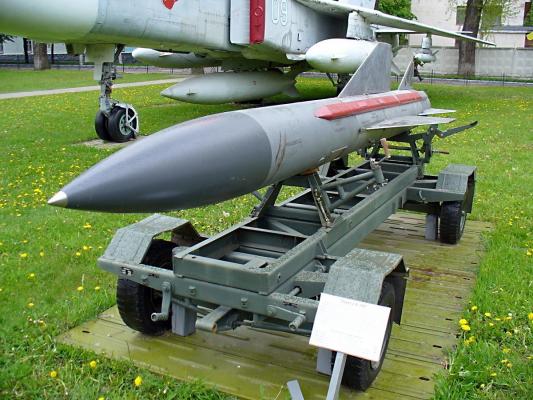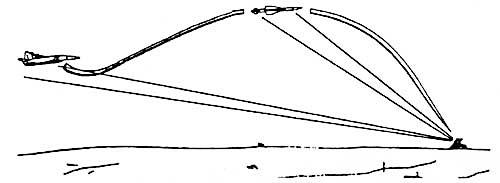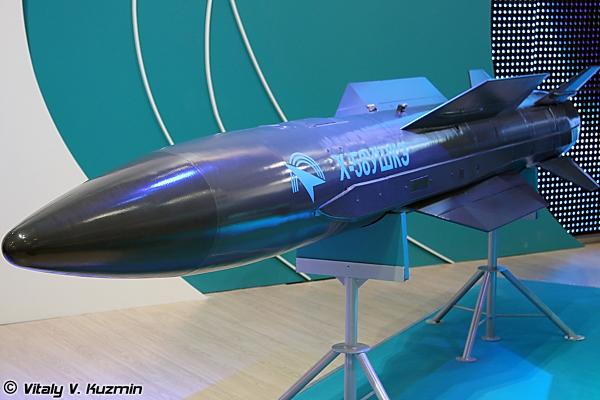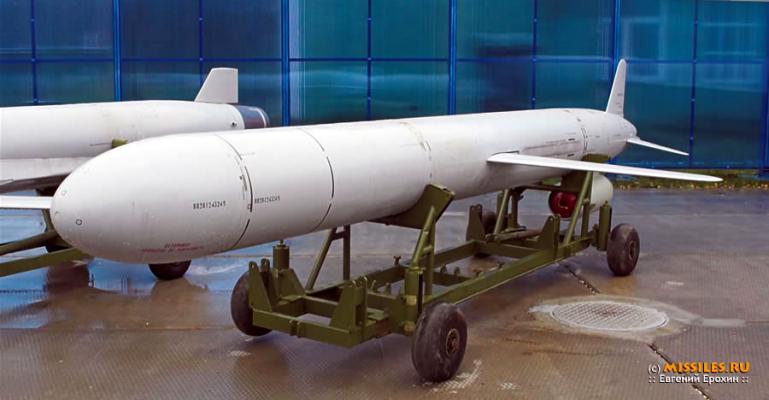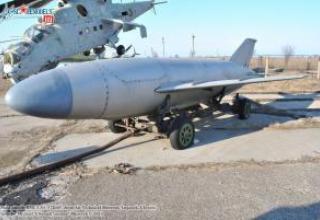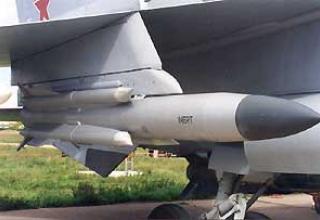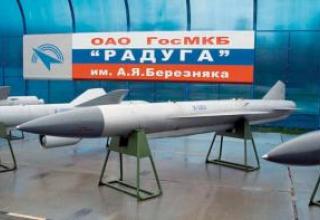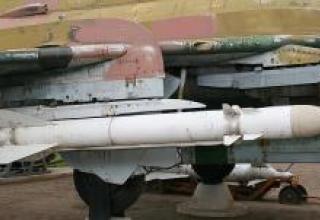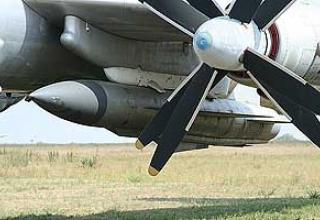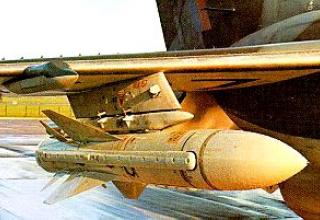The X-58U missile is designed to engage radar stations (radars) without the aircraft carrier entering the affected areas of anti-aircraft missile systems (SAMs) such as Hawk, Nike Hercules, Patriot. The missile's combat application is ensured under any weather conditions (rain, snow, fog), at any time of the year without restrictions on the geographical latitude of the launch site.
X-58 missile was created in the ICB "Rainbow" under the guidance of chief designer - I.S.Seleznev. The main carrier of missiles was a specialized aircraft MiG-25BM, which hangs up to four missiles Kh-58. Installation of Kh-58 missiles on the aircraft type MiG-25 was set by the decision of the CPSU Central Committee and the USSR CM in 1972. The task was to defeat the tune-up, short-term shutdown for camouflage radars with a wide range of radiation. In addition, it required the ability to select the most dangerous objects and redirect them.
The development of the PRGS-58 homing head and the Jaguar aircraft system providing radar target detection was entrusted to the Omsk Central Design Bureau of Automation. Together with the base aircraft MiG-25 and needed to refine the rocket for installation on this aircraft. The prototype of MiG-25BM was created in 1976.
In 1974, began flight tests PRGS-58 on the flying laboratory of the AN-12, flight and design tests of the Jaguar complex deployed in 1977, and in 1980 a new missile was adopted for service. Joint tests of the armament complex by industry and the customer proved to be long lasting and were completed by 1982. In addition to X-58, which provided the fight against enemy complexes operating in the frequency bands A, B and C, was created an improved X-58U with an extended range of A, A, B and C. Under the name X-58U (U - unified) the missile also became part of the Su-24 and Su-24M armament. Kh-58U has an extended flight range and differs from Kh-58 in its new engine and improved aerodynamic plumage.
The Su-17MZ and M4 were equipped with "Vyuga-17" (item L-086) suspended control and target designation equipment in a suspended container, developed by the Central Design Bureau under the leadership of V. Slavin, which also provided for the use of X-27PS anti-radar missiles. The Su-24M uses "Phantasmagoria" equipment in two sets of replaceable containers "A", "B" and "C" (products L-080 and L-081), depending on the type and litres of the intended radar target. It is an improved version of the previous on-board system "Filin-N" used on the Su-24, and features an extended range and improved performance. The equipment was mass-produced at the Barnaul plant. The CKBA also developed a unified PA-UR "Progress" target designation system for the Su-17, MiG-27 and MiG-23, which served for the use of existing (Kh-58, Kh-27PS, Kh-25MP) and advanced missiles, but work on this system was curtailed due to the removal of these vehicles from service.
Kh-58E is used in the armament of Su-24MK, Su-22M4, Su-25TK and MiG-25BM type aircraft. At present, the Rainbow Design Bureau is proposing a project to use the Kh-58E missile system with foreign fighter aircraft of the Mirage-111E, F-15, F-16 types.
The last version of the Kh-58 family missile was designated Kh-58USHKE (see photo). Kh-58USHKE is much shorter than Kh-58, is equipped with a new homing head and is designed for intra-fuselage placement on the carrier.
According to the advertising information: an improved modification of Kh-58A missile is being created to engage surface ships of small and medium displacement.
In the west, the missile was designated AS-11 "Kilter".
Composition:
The X-58U rocket is programmed before launching the built-in "Phantasmagoria" (Su-24M) or suspended "Vuga" special equipment. Domestic aircraft are mainly equipped with the integrated reconnaissance and target designation system of Kh-58U - "Phantasmagoria" missiles.
The missile system with Kh-58E rocket includes:
- a rocket,
- a universal overhead container "Vuga",
- aircraft catapult device,
- the operator's console and the target indicator.
The X-58 missile (see projections, layout diagram) is built according to the normal aerodynamic scheme with a fixed wing of a large area. The structure is all-metal (stainless steel 30ХГСА, wings and fins made of titanium OT4-1). The wing is trapezoidal in plan. Aileronov X-58U does not have, and control of all three channels (roll, pitch and yaw), carried out by the deviation of the steering wheel.
The power unit consists of a rocket dual-mode solid fuel engine with a central nozzle.
In terms of energy performance X-58U is comparable to air combat missiles (for comparison: its thrust-to-weight ratio is more than twice that of the similar parameter X-23 and X-25). In the tail compartment around the nozzle block are the steering drives - unconventional in missiles of this class electromechanical machines. The choice of electromechanical power units was dictated by the same long range and duration of flight, for which the resources of air or gas generator power was not enough. The high-capacity on-board nickel cadmium battery with static current converter ensures the operation of systems and steering for at least 200s . Kinetic heating in flight with high speed makes 400 - 500° that has caused wide application of stainless steel - chromansil 30ХГСА and titanium OT4-1 as the basic constructive materials. Titanium is fully welded to the wing and plumage, including cladding and edges. The power set of the fuselage is welded from steel, and the units and parts made of light alloys have unconventional external heat protection made of heat-resistant sealant.
High characteristics of the missile are achieved by the transition to a modern element base of multichannel SAU and guidance equipment. Placement of equipment and systems required an increase in internal volumes, and during the development of the X-58U the diameter of its body was determined equal to 380 mm (against 275 mm at the ASD X-25 and X-27PS).
The control system of SAU-58 is an inertial multi-channel control system with passive radar SOS of type PRGS-58 (PRGS-58M). SOS X-58 of PRG-58M type provides guidance to radars operating in the ranges of A, A', B', C, including those operating in the pulse mode and with tunable frequency (within the operating range of the head). The direction finding device made according to the superheterodyne scheme (with the search heterodyne) has high sensitivity, interference immunity and allows to carry out pointing to the radars, applying the tuning of the carrier frequency from pulse to pulse. The control system also includes a rollover that stores the "memory" of the target position when it is switched off or a "flickering" covert operating mode for up to 15 seconds.
PRG-58M provides selection of the radar target in the spatial strobe ± 5 ° on the carrier frequency and the repetition period, auto tracking of the target selected by the pilot (operator) in the range of angles: at a rate of ± 30 °, on the pitch - from +10 ° to - 47 °. In the auto support mode, the CWR gives signals proportional to the angle of bearing and angular velocity of the target sighting line to the control system. The missile makes a "slide" before the target. Circular probable deviation (hit probability - 80%) - 20 m.
The blast furnace with the weight of 149 kg with 58.5 kg BB is equipped with a non-contact fuse ROV-20, triggered when flying over the target at an altitude of up to 5m, as well as included electromechanical fuse device with inertial sensors (more reliable and safe than conventional contact sensors), triggered by overloads at direct hit. The X-58U is also equipped with a nuclear BC.
For the suspension of the X-58 is a special aircraft catapult device AKU-58 or AKU-58-1.
A sealed container is used for transportation and storage.
At start-up the pneumatic pusher catapult device leads the missile to a safe distance from the aircraft carrier. After the launch of the rocket carrier aircraft does not take part in the guidance, and the pilot is free to maneuver and leave the target. The rocket engine after starting within 3.6 seconds operates in the maximum thrust (6000 kgf), carrying out acceleration. Then, by profiling a solid propellant checker with a smaller combustion area, the thrust is reduced to 1000 kgf and the engine runs in marching mode for 15 seconds. The missile is stabilized on the roll, pitch and yaw, after which the autopilot begins to gain altitude until the current angle of bearing the target will not be equal to the specified (calculated on board the aircraft carrier and memorized in the memory circuit of the rocket control system at the time of its launch). Then it turns to the target with a given overload, after which the system switches to passive homing mode by the method of proportional approach. Before the target, the missile performs a "slide". The BC is detonated when flying over the target at a distance of about 5 m or a direct hit.
In case of stealth approach to air defense objects and launch from a height of 100m, the range of fire is 60 km, reaching 250 km when attacking from 10 km height (see launch zones).
With the advent of new types of weapons and equipment, more promising applications and tactical techniques were also proposed: for example, the Su-25T attack aircraft could be fitted with special S-13ALT anti-aircraft targets launched on course when approaching the air defence zone and simulating the attacking aircraft, "provoking" the operation of enemy systems. Their parameters are recorded by the onboard control system "Pastel", notifying the pilot and automatically generate commands to the jamming complex and the data of target designation SOS X-58U for missile attack on "lighted" targets.
X-58USHKE (see Photo 2) missile of indoor and outdoor deployment with a wide-band (combined range A, A', B', C) passive homing radar head and a navigation and automatic control system based on a free navigation system is intended to engage ground-based radar stations operating in pulsed mode in the range of 1.2 ... 11 GHz carrier frequency and in the mode of continuous radiation in the range A. The application of the missile is provided both on the programmed radar targets and on targets quickly detected by the target designation system of the aircraft carrier.
Kh-58USHKE rocket has a smaller wingspan and can be used both from the external points of suspension of modern aircraft equipped with a target designation system and equipped with an aircraft catapult unit type AKU-58, and from inside the fuselage suspension points (with catapult unit type UVKU-50). The rocket's solid propellant engine accelerates it to a speed of 4200 km/h, which makes the X-58USHKE virtually invulnerable to existing and future air defense facilities, as well as gives the aircraft-bearer advantages in a duel situation in the fight against ground and ship air defense facilities.
For transportation and storage of Kh-58 missiles a sealed container is used.
Characteristics:
| Range of fire, km | |
| - minimum | 10 |
| - maximum at startup 100m | 60 |
| - maximum with MiG-25BM | 200 |
| - maximum at launch from a height of 10 km | 245 (200 for X-58E) |
| Shooting accuracy (CWO), m | 5-8 |
| Flight Speed, km/h. | 4200 |
| Launch height, km | 0.1-22 |
| Flying speed of the carrier, km/h | |
| - for a standard rocket | 550-1800 |
| - for an upgraded missile | 550-2800 |
| Target angle at missile launch | ±15° |
| Fighting unit | |
| - type | blast |
| - weight,kg | 149 |
| - lesion radius, m | 20 |
| - fuse type | non-contact |
| Number of steps | 1 |
| The length of the rocket, mm | 4813-4850 (4190 for X-58USHKE) |
| Maximum rocket body diameter, mm | 380 |
| Wingspan, mm | 1170 (800 for X-58USHKE) |
| Start weight , kg | 640-650 |
| Aircraft launcher | |
| Type | ACU-58 |
| Weight of empty PU, kg | 185 |
| Length PU, mm | 3810 |
| PU width, mm | 130 |
| Height PU, mm | 220 |
| Transport container | |
| - empty weight,kg | 350 |
| - length,mm | 5635 |
| - width,mm | 990 |
| - height, mm | 874 |
Testing:
The first flight of the prototype carrier aircraft Tu-95M-55 (BM-021) took place on July 31, 1978. A total of 107 flights and launches of ten X-55s were made on this machine by the beginning of 1982. The plane was lost in the crash January 28, 1982 on takeoff from Zhukovsky because of pilot error.
The tests of the X-55 were very intensive, which was facilitated by a thorough pre-testing of the control system on the model stands of NIIAS. During the first stage of the tests 12 launches were conducted, only one of which failed due to the power system generator failure. In addition to the missile itself, the weapon control system was brought to the surface of the launch vehicle, which was used to launch the mission and exhibit the missile's gyroinertial platforms.
The first launch of the serial X-55 was made February 23, 1981. September 3, 1981 the first set-off launch was made with the first production car Tu-95MS. Tests of the complex were conducted on the route measuring complex of the 929th LIC. Test launches of X-55 were carried out virtually the entire range of flight modes of the carrier from altitudes of 200m to 10km. The engine was launched reliably, the speed on the route, adjustable depending on weight loss during fuel production, was maintained in the range of 720-830 km/h. With a given value of CVO not more than 100m in a number of starts a deviation of only 20-30m was achieved.
The first to master the new complex started in Semipalatinsk 1223rd TBAP, which on December 17, 1982. arrived two new Tu-95MS. Since 1984, retraining on the Tu-95MS began adjacent 1226th TBAP of the same Semipalatinsk 79th TBAD. At the same time there was equipping of Tu-95MS regiments YES in the European part of the USSR - 1006 TBAP in Uzin near Kiev and 182nd TBAP in Mozdok, which was part of the 106th TBAD. In the division were concentrated more advanced Tu-95MS-16. The first Tu-160 arrived in April 1987 in the 184th TBAP, which was located in Priluki in Ukraine. Three months later, August 1, 1987 the crew of regiment commander V.Grebennikov first performed the launch of X-55.
After the collapse of the USSR, most of the X-55 missiles and their carrier aircraft remained outside Russia, in particular, in Kazakhstan and Ukraine, where there were, respectively, 40 Tu-95MS in Semipalatinsk, 25 in Uzin and 21 Tu-160 in Priluki. Together with the aircraft in the Ukrainian bases remained 1068 missiles X-55. With Kazakhstan, we managed to agree quickly enough, exchanging heavy bombers for proposed Russian fighters and attack aircraft. By February 19, 1994 all TU-95MS were ferried to the Far Eastern airfields, where they were equipped with the 182nd and 79th TBAP. The negotiations with Ukraine lasted a long time. Eventually, three TU-95MS and eight TU-160, which flew to Engels in February 2000, were transferred by the Ukrainian side on account of debts for gas. At the end of 1999, 575 air-based cruise missiles X-55 and X-55SM were also delivered from Ukraine to Russia.
In the Russian Air Force, all the forces of the YES were combined into the 37th Air Force. In its composition by July 2001, there were 63 Tu-95MS aircraft with 504 missiles Kh-55, as well as 15 Tu-160. The first practical launch of X-55SM from the Tu-160 was made by the crew of Colonel A. Zhikharev October 22, 1992. In June 1994, four Tu-95MS and Tu-160 took part in the exercises of the Russian Strategic Nuclear Forces, having worked out tactical launches over the North Sea and then executed the actual firing of X-55SM at the range. In September 1998, a group of four Tu-95MS 184th TBAP were made launches of X-55 in the area of the Northern Fleet training ground Chizha, where the missiles were 1500 km to the target.
During the exercise "West 99" in June 1999, a pair of Tu-95MS from Engels performed a 15-hour flight, reaching Iceland, and on the way back made a launch of X-55 on a training target in the Caspian Sea. In October 2002, the crew of the Tu-160 Colonel Yu Deineko in a night flight passed the route over the circumpolar areas, performing a practical launch of X-55SM. May 14, 2003 the four Tu-95MS and six Tu-160 participated in exercises covering the Persian Gulf and the Indian Ocean. Launches of the X-55 from the Tu-95MS were held during the strategic command training of land, sea and air SNF in February 2004.
Sources:
- А.В.Карпенко, С.М. Ганин "Отечественные авиационные тактические ракеты", "Бастион" N1, 2000г.
- В.Марковский, К.Перов "Советские авиационные ракеты "воздух-земля", М., Экспринт, 2005г.
- Управляемая противорадиолокационная ракета Х-58Э
- Ракета Х-58УШКЭ

